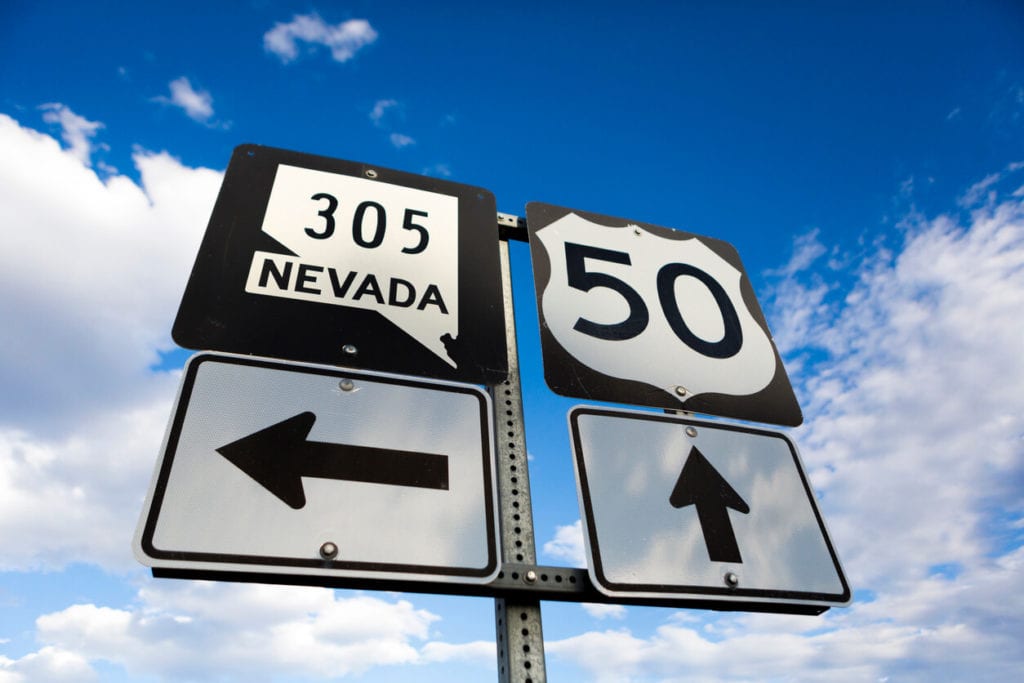At the tick tock of the clock into 2020, the State of Nevada enacted some new driving laws that may affect how you motor about town. Whether you’re an experienced driver looking to refamiliarize yourself with the laws, you’re a new resident of Nevada, or just passing through, it’s important to understand and obey the laws of the road. 
Being up-to-date on any changes in laws can help prevent you from making a costly mistake resulting in an accident or traffic violation. Here are some new Nevada driving laws you need to be aware of.
New Driving Laws for Nevada in 2020
- Helmet law – Nevada motorcyclists, moped, and trimobile riders as well as their passengers are required to wear helmets. Failure to do so is considered a misdemeanor.
- Trick driving – Trick driving stunts including street racing on public highways that is deemed dangerous or where traffic is significantly slowed down or diverted is strictly prohibited. Violators of this law are subject to a $1000 fine, possible jail time, 100 hours of community service, Nevada license suspension up to two years, and impoundment of the vehicle.
- Reckless driving and Vehicular Manslaughter Provisions – Reckless driving and unauthorized speed contests are illegal on highways as well as other public access areas. Violators may be punished for reckless driving or vehicular manslaughter if guilty of disregarding the safety of people or property on roads, in neighborhoods, parking lots or parking garages, etc.
- Caps on Speeding Fines – The maximum fine for speeding is limited to $20 for each mile over the speed limit. The law also specifies that it’s illegal to drive at speeds that result in injury of other persons or property damage. Courts may also reduce the speeding citation for all non-moving violations if wrongdoers pay all fines prior to their first appearance in court.
Nevada Cell Phone Laws
Nevada’s Distracted Driving law prohibits the use of cell phones while in the vehicle. However, there are exceptions to this rule that allow for first responders and drivers to use their phones in certain situations such as in an emergency.
Texting
The Nevada texting law strictly prohibits texting or otherwise accessing the internet on your cell phone while driving. Fines for the first offense, within seven years, is $50, $100 for the second, and $250 for the third and each one thereafter. While the first offense is not considered a moving violation, a second offense or more carries 4 demerit points. The point system is considered a driver improvement program wherein each violation collects points. If you have collected between 3 and 11 points, they can be removed by taking a DMV-approved traffic safety class. 12 or more points collected in a 12-month period is an automatic 6-month driver license suspension.
Calls
In addition to prohibiting texting, the Nevada cell phone law prohibits drivers from using handheld devices while driving. Drivers are permitted to use a hands-free option that is voice activated. Drivers are temporarily permitted to use their hands to activate or deactivate their voice-operated functions.
Child Restraint Systems & Seat Belt Laws
Nevada’s seatbelt laws state that both front and rear passengers must have seat belts or be properly restrained in a child safety seat. Nevada’s child seat law states that children under the age of six who weigh less than 60 pounds must be in a proper car seat. Violation of this law can be as lenient as a fine or community service to suspension of your driver’s license.
Move Over or Slow Down
Drivers are required to decrease speed as necessary and proceed with caution when approaching an emergency vehicle or other traffic incidents such as an accident. Drivers should also be prepared to stop and if possible, move to the nearest shoulder. In accidents where there is property damage to a vehicle or other, and where your vehicle is obstructing traffic, if you are able move the vehicle to a safe area and return to where the incident occurred.
Amendment for 2020: Tow trucks are now permitted to use non-flashing blue lights to alert other drivers of their presence when towing a vehicle or approaching a vehicle that needs to be towed.
Laws On Pets and Children In Vehicles
It is unlawful to leave a child younger than the age of 7 in a vehicle unattended, especially in instances where the child’s health is at risk, unless the child is supervised by a person aged 12 and older. Children under the age of 18 are prohibited from riding in the back of a pickup or flatbed truck, except in cases of farming, ranching, or parades.
It is illegal to leave a domesticated animal such as a dog or cat unattended in a vehicle during extreme hot or cold weather. Peace officers and firefighters are authorized to use any force necessary to gain access into the vehicle to rescue the animal in danger.
Drinking and Driving
Nevada’s limit for blood alcohol content (BAC) is .08 and .04 for commercial drivers. However, some drivers may be arrested and convicted of a DUI with a lower BAC level if driving under the influence of controlled or illicit substances; this is known as the Illegal Per Se Law. Drivers are required to submit to a BAC test.
If the driver refuses, the officer is permitted to arrest the offender under penalty of resisting arrest. Penalties for DUI or DWI are harsh and include hefty fines, DUI classes, revocation of driver’s license, vehicle suspension, jail time, and more. Getting behind the wheel under the influence is not worth the risk of your life, the life of others, or the punishment that comes with it.
Other Helpful Reminders
Certain driving laws can vary from state to state, for example, the “Basic Rule.” Most drivers should understand that all drivers should drive at reasonable speeds. This means, drivers must follow all posted speed limits but also take into account the amount of traffic, weather and road conditions, and other such contributing factors. If you’re a new resident of Nevada, or simply need a refresher, here are some basic tips for driving in the Silver State:
- Right on red is permitted at all intersections unless posted otherwise. Drivers must come to a full and complete stop, yield to pedestrians, and be in the “extreme right-hand lane” before proceeding.
- U-Turns are typically permitted as long as they can be completed safely. U-turns are prohibited where there is less than 500 feet of visibility in either direction or where signs indicate no U-turn. Illegal U-turns in Nevada are subject to a $230 fine and 3 demerit points.
- School Bus Safety. Motor vehicle drivers traveling in both directions are required to stop when students are boarding or disembarking from a school bus and when the bus has flashing red lights activated. In areas with a median or other physical barrier, traffic in the opposite direction is not required to stop.
Driving safely is smart and prevents accidents or the expense of a traffic ticket. When you’re driving in Nevada, be sure to follow all posted traffic speeds and use caution in all road conditions.
Following these basic Nevada driving laws will keep you and your passengers safe while on the road. To keep your car in safe driving condition, keep up on maintenance and repairs with Sun Auto Service. We have several locations throughout the Las Vegas and Henderson areas to serve you. Schedule your next appointment for auto service today!
